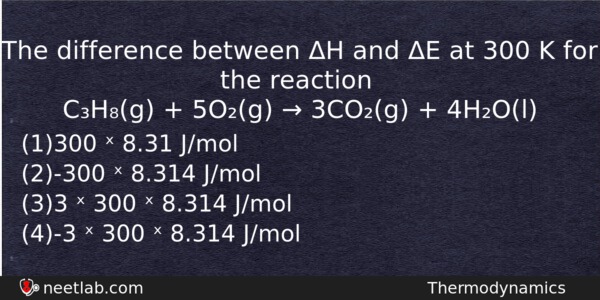| ⇦ | 
| ⇨ |
The difference between ΔH and ΔE at 300 K for the reaction
C₃H₈(g) + 5O₂(g) → 3CO₂(g) + 4H₂O(l)
Options
(a) 300 ˣ 8.31 J/mol
(b) -300 ˣ 8.314 J/mol
(c) 3 ˣ 300 ˣ 8.314 J/mol
(d) -3 ˣ 300 ˣ 8.314 J/mol
Correct Answer:
-3 ˣ 300 ˣ 8.314 J/mol
Explanation:
ΔH = ΔE + Δn(g)RT
or ΔH – ΔE = Δn(g)RT,
where Δn(g) = (3) – (5 + 1) = -3.
Thus, ΔH – ΔE = -3 * 8.31 *300 J/mol.
Related Questions: - Magnetic moment 2.83 BM is given by which of the following ions
- Aniline on reaction with acetyl chloride gives
- The electronic configuration of chalcogens is
- Increasing order of rms velocities of H₂,O₂,N₂ and HBr is
- Method by which aniline cannot be prepared is
Topics: Thermodynamics
(179)
Subject: Chemistry
(2512)
Important MCQs Based on Medical Entrance Examinations To Improve Your NEET Score
- Magnetic moment 2.83 BM is given by which of the following ions
- Aniline on reaction with acetyl chloride gives
- The electronic configuration of chalcogens is
- Increasing order of rms velocities of H₂,O₂,N₂ and HBr is
- Method by which aniline cannot be prepared is
Topics: Thermodynamics (179)
Subject: Chemistry (2512)
Important MCQs Based on Medical Entrance Examinations To Improve Your NEET Score
18000+ students are using NEETLab to improve their score. What about you?
Solve Previous Year MCQs, Mock Tests, Topicwise Practice Tests, Identify Weak Topics, Formula Flash cards and much more is available in NEETLab Android App to improve your NEET score.
Share this page with your friends

Leave a Reply